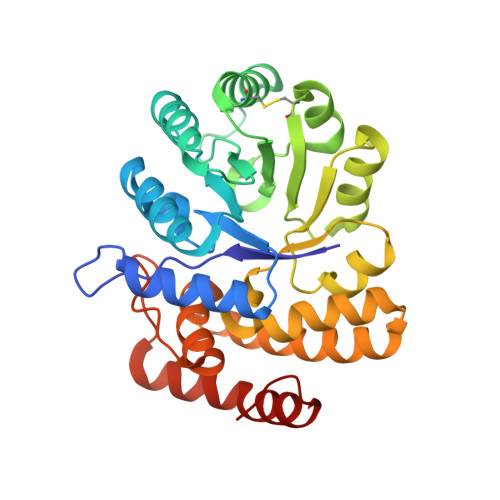The structural basis for substrate promiscuity in 2-keto-3-deoxygluconate aldolase from the Entner-Doudoroff pathway in Sulfolobus solfataricus.
Theodossis, A., Walden, H., Westwick, E.J., Connaris, H., Lamble, H.J., Hough, D.W., Danson, M.J., Taylor, G.L.(2004) J Biol Chem 279: 43886-43892
- PubMed: 15265860
- DOI: https://doi.org/10.1074/jbc.M407702200
- Primary Citation of Related Structures:
1W37, 1W3I, 1W3N, 1W3T - PubMed Abstract:
The hyperthermophilic Archaea Sulfolobus solfataricus grows optimally above 80 degrees C and metabolizes glucose by a non-phosphorylative variant of the Entner-Doudoroff pathway. In this pathway glucose dehydrogenase and gluconate dehydratase catalyze the oxidation of glucose to gluconate and the subsequent dehydration of gluconate to D-2-keto-3-deoxygluconate (KDG). KDG aldolase (KDGA) then catalyzes the cleavage of KDG to D-glyceraldehyde and pyruvate. It has recently been shown that all the enzymes of this pathway exhibit a catalytic promiscuity that also enables them to be used for the metabolism of galactose. This phenomenon, known as metabolic pathway promiscuity, depends crucially on the ability of KDGA to cleave KDG and D-2-keto-3-deoxygalactonate (KDGal), in both cases producing pyruvate and D-glyceraldehyde. In turn, the aldolase exhibits a remarkable lack of stereoselectivity in the condensation reaction of pyruvate and D-glyceraldehyde, forming a mixture of KDG and KDGal. We now report the structure of KDGA, determined by multiwavelength anomalous diffraction phasing, and confirm that it is a member of the tetrameric N-acetylneuraminate lyase superfamily of Schiff base-forming aldolases. Furthermore, by soaking crystals of the aldolase at more than 80 degrees C below its temperature activity optimum, we have been able to trap Schiff base complexes of the natural substrates pyruvate, KDG, KDGal, and pyruvate plus D-glyceraldehyde, which have allowed rationalization of the structural basis of promiscuous substrate recognition and catalysis. It is proposed that the active site of the enzyme is rigid to keep its thermostability but incorporates extra functionality to be promiscuous.
Organizational Affiliation:
Centre for Biomolecular Sciences, University of St. Andrews, North Haugh, Fife KY16 9ST, Scotland.


















